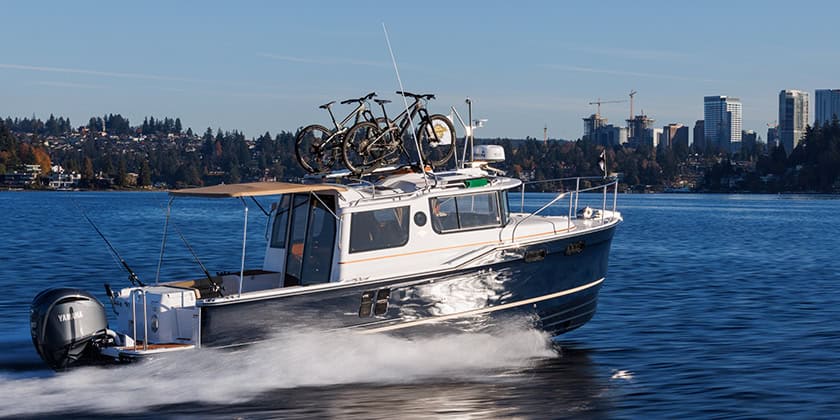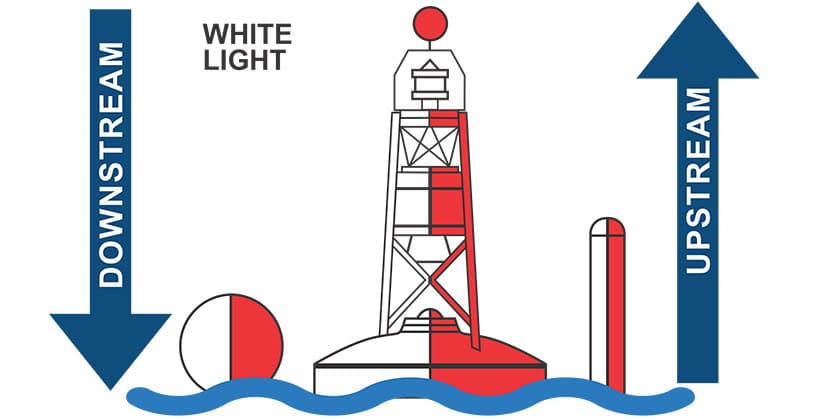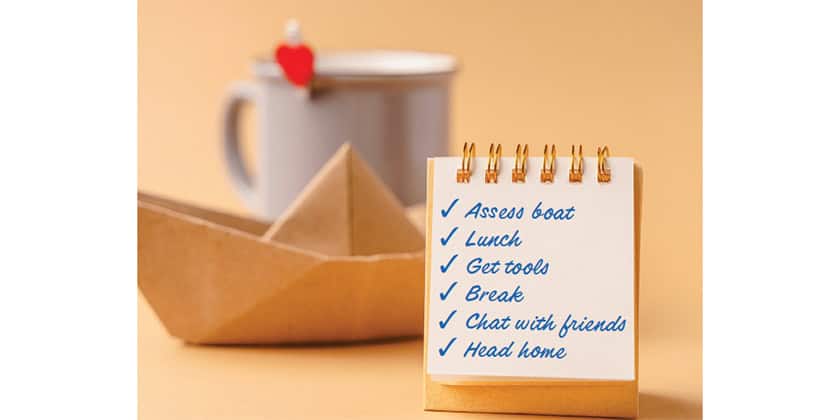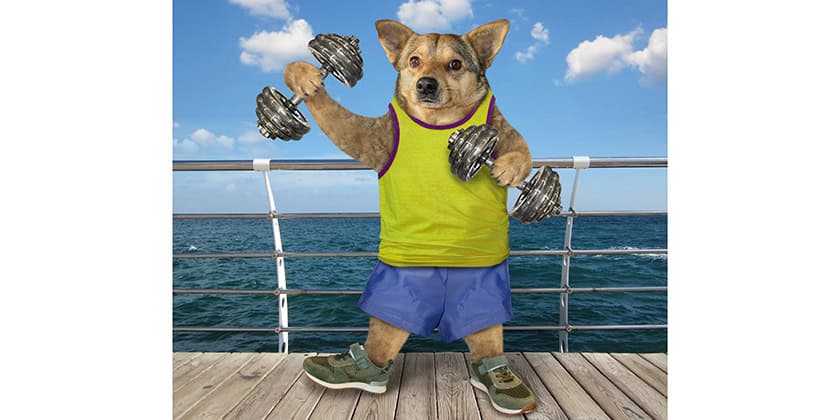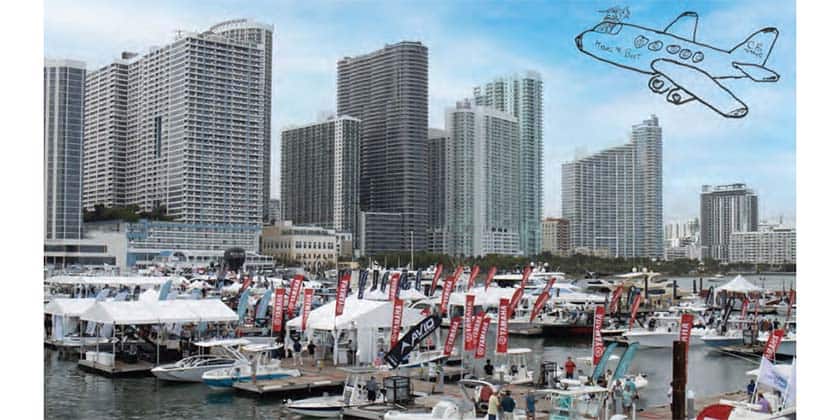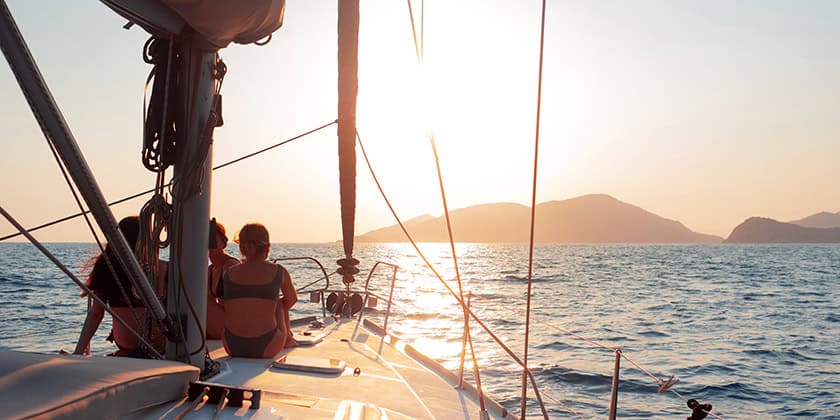Rossiter 23 Runabout
Form follows function
By Andy Adams
The Rossiter 23 Classic Day Boatis both a logical extension of the Canadian-built Rossiter line and a boat that breaks new ground for the company. We think Canadian Yachting readers will find this boat very interesting because it’s so well suited to the way people are using their boats today
First, a bit of history:Rossiter boats was foundedmore than 40 years ago by George Rossiter, who grew up on Georgian Bay. George loved the local regatta and especially the rowing competitions featuring the double-ended rowing skiffs. Over the years, those boats slowly wore out, so to keep things going, George became a boat builder, first learning how to repair them and later building new ones.
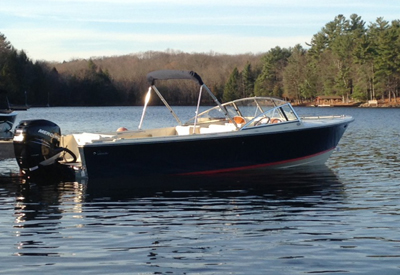 Ultimately, Rossiter’s rowing skiff,The Loudon, became a fiberglass boat. Later, looking for a useful small outboard runabout that could handle Georgian Bay conditions and inspired by the family’s Bertram, George developed the 14-foot Side Console model.
Ultimately, Rossiter’s rowing skiff,The Loudon, became a fiberglass boat. Later, looking for a useful small outboard runabout that could handle Georgian Bay conditions and inspired by the family’s Bertram, George developed the 14-foot Side Console model.
Our test boat with its super-charged Mercury Verado 225 engine on Lake Muskoka.
Although things were going well with the boat company, by 2007 George had come to a point in his life where he was prepared to sell the company. Scott Hanson, who was a Canadian and a graduate of the Landing School of Boat Building and Design,met George and bought the business, assuring George that his legacy was in capable hands.
With a strong business and marketing background, Scott has steadily expanded both the dealer network and the range of Rossiter boats they build, adding several rowing boats and expanding the outboard line from the 14 to the Rossiter17.
Now, the Rossiter 23 Classic Day Boat has been introduced. Tooled in 2013 and introduced at the Toronto International Boat Show in 2014, the 23 is a boat created in response to input and ideas from owners and Rossiterdealers who had come to know the 14 and 17 models.
The 23 hasa timeless, classic look that some people would describe as a “down East style,” and the boat is very popular down the Eastern Seaboard to Florida. But it is not an old-fashioned design, the lines reflect the ‘form follows function’approach and the design just immediately makes sense when you see it.
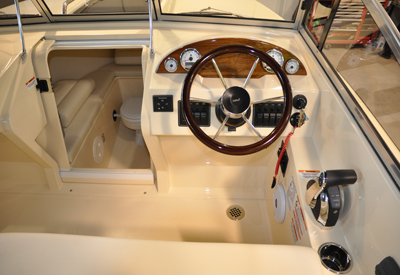 The ergonomics are very good with lots of room for a driver and companion on the helm seat. Love the wooden wheel and dashboard…
The ergonomics are very good with lots of room for a driver and companion on the helm seat. Love the wooden wheel and dashboard…
We can’t imagine it would ever go out of fashion because the lines are so attractive yet practical. The bow has enough flare to send spray well out to the sides. The windshield is fairly upright and high for an unobstructed view forward and real protection from the wind and the rain.
While so many new boats have rear-facing or wraparound passenger seats, the Rossiter has a forward facing companion seat as well as a double-sized helm seat. Then there is a full-width bench seat across the transom plus three aft-facing seats midship, creating a conversation area in the cockpit.
A removable table is available. Every seat is adult sized and chair-height for all-day comfort. The windshield is big enough to minimize buffeting, even for the passengers in the back. There is seating for ten.
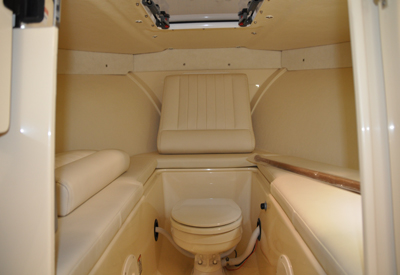 To ensure all-day comfort, a head is essential and this one is properly plumbed, private in the cuddy cabin and the deck hatch brings in daylight…you can even open the hatch for more “headroom”.
To ensure all-day comfort, a head is essential and this one is properly plumbed, private in the cuddy cabin and the deck hatch brings in daylight…you can even open the hatch for more “headroom”.
Another very appealing feature is the big expanse of flat floor. It makes moving around the boat easy, safe, and secure. Six large scuppers drain water off fast. There is a large, overboard-drained ice chest / fish box that holds 33.9 gallons and generous storage under the seats, in the side panels, and cuddy.
These are just some of the design features that Rossiter owners said they most valued in their 17s. For island cottagers in the Great Lakes, Georgian Bay, the Muskoka’s,the Thousand Islands, and families on the American East Coast, where many Rossiters are sold, there was a demand for more seating and greater cargo capacity. While the 17 was an ideal and timeless cottage boat, the 23 is the bigger version that takes the company into a picnic boat or day boat that can handle even bigger water.
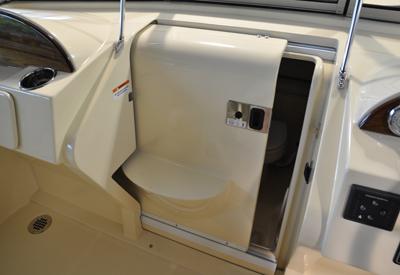 The sliding door to the cuddy cabin also features a built-in step. The windshield centre section opens for easy and safe access to the deck.
The sliding door to the cuddy cabin also features a built-in step. The windshield centre section opens for easy and safe access to the deck.
While it has no galley or cooking facilities on board, a BBQ could certainly be added by the swim platform and the 23 has a fairly spacious enclosed vee-berth that has a deck hatch for daylight and a proper plumbed head is available. This adds important comfort for a full day on the water and the cabin is a safe place for an infant or to stow personal items.
The sliding door has a step built in and the big skiff-style windshield has a swing-open centre section so you can easily get forward onto the deck, which is broad and flat. An anchor windlass is an option. The hatch has been positioned so you can also access the deck and anchor from the safety of the cuddy.
Another feature is the available convertible roof. The test boat had the Bimini version with 6’3” of headroom and side curtains offeringfull enclosure if you want it. Although we had rain for the test day, we stayed dry and comfortable, plus many owners will value the shade even more, especially during a full day on the water.
Rossiter has installed ‘sway bars’ on the top bow to keep it from moving from side to side and the sturdy frame makes a convenient handhold when you’re stepping in at dockside. You can also step in at the stern where there is a spacious swim platform with a transom door into the interior. There is an available shower for saltwater swimmers and we were pleased to see that the excellent four-step boarding ladder can easily be deployed, even by someone in the water. That’s a great safety feature.
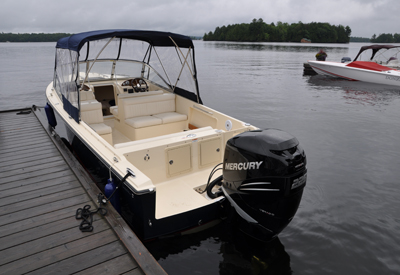 The over cast weather was no issue because the Bimini top kept us dry and comfortable plus, there’s standing headroom.
The over cast weather was no issue because the Bimini top kept us dry and comfortable plus, there’s standing headroom.
The design gives a convenient spot to sit on the bulkhead and put on a ski or a wakeboard, and the available pop-up ski pylon is an understandably popular option.
We met Scott Hanson at Walker’s Point Marina on Lake Muskoka for our session with the Rossiter 23. This boat was rigged with a 2.6 litre, inline sixcylinder, fuel injected, and supercharged 225 hp Mercury Verado engine.
One twist of the key and it’s running, but you virtually cannot hear it. Check the tachometer to see that it’s idling! For a boat that can handle a big group, the 23 tracks easily at idle speeds and you could do an effortless, slow sightseeing trip in near silence.
The helm position displays excellent ergonomics. You could comfortably drive this boat all day and there’s room on the helm seat for a spouse or grandchild.
Get on the throttle and the Rossiterand Verado combination delivers brisk acceleration with very little bow rise. You will never lose sight of the horizon with this boat. It seemed happy to run just about any speed and planed off at 15 mph. It was not at all sensitive to the engine trim settings, although it benefits from some trim at higher speeds and trim tabs were fitted to enable you to force the bow down for really rough water or to level the boat in a side wind.
Scott Hanson told me that the deepvee hull design includes a planing pad and a small stepat the transom, allowing the engine to also be raised a few holesto add an extra three to four miles per hour on the top end without compromising efficiency. Turning in hard was easy, and even at high speeds, cranking the 23 right over felt secure and well controlled. The Mercury Verado 225 delivers plenty of acceleration for use with tow sports or to plane off a big load of passengers and gear.
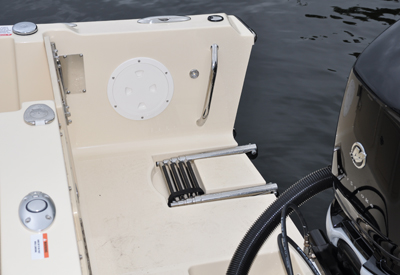 The Rossiter is full of thoughtful and functional features. Here is the deep 4-step boarding ladder that can be deployed from the water, well positioned hand rail to help you up. recessed deck cleats for safety, and on the transom top, a recessed ski pylon that pops up when it’s time for fun.
The Rossiter is full of thoughtful and functional features. Here is the deep 4-step boarding ladder that can be deployed from the water, well positioned hand rail to help you up. recessed deck cleats for safety, and on the transom top, a recessed ski pylon that pops up when it’s time for fun.
The Rossiter 23 shows evidence of very solid construction and excellent hardware everywhere you look. Adding to the appeal, there are several hull colour and upholstery combinations as well as deluxe touches you can choose from,like faux teak flooring or a real wooden steering wheel, that can make your 23 unique.
The ‘form follows function’ design results in an impressive package that will have timeless appeal.
Specifications
Engine: Mercury Verado225, 225 hp, 2.6 litre, inline six cylinder, supercharged with charge air cooling and electronic boost pressure control, sequential multi-port electronic fuel injection (EFI), electro-hydraulic power steering, SmartCraft digital controls.
ENGINE RPM MPH
Idle
1,000 1.2
1,2502.0
1,5002.4
1,750 2.8
2,0003.6
2,2504.8
2,5006.1
2,7508.1
3,00013.0
3,25018.3
3,50023.7
3,75027.6
4,00030.9
4,25033.4
4,50036
4,75037.8
5,000 39.8
5,250 45.3 max
Length overall (no engine): 22’5″ [6.83 m]
Beam: 8’5 ½ ” [2.57 m]
Displacement (dry, no engine): 3,220 lbs. [1,460 kg]
Fuel capacity: 70 gals [264 L]
Maximum power: 250 hp
Price: CDN $113,435 as tested
Test boat, performance data and pricing supplied by: Walkers Point Marina www.walkerspointmarina.com










